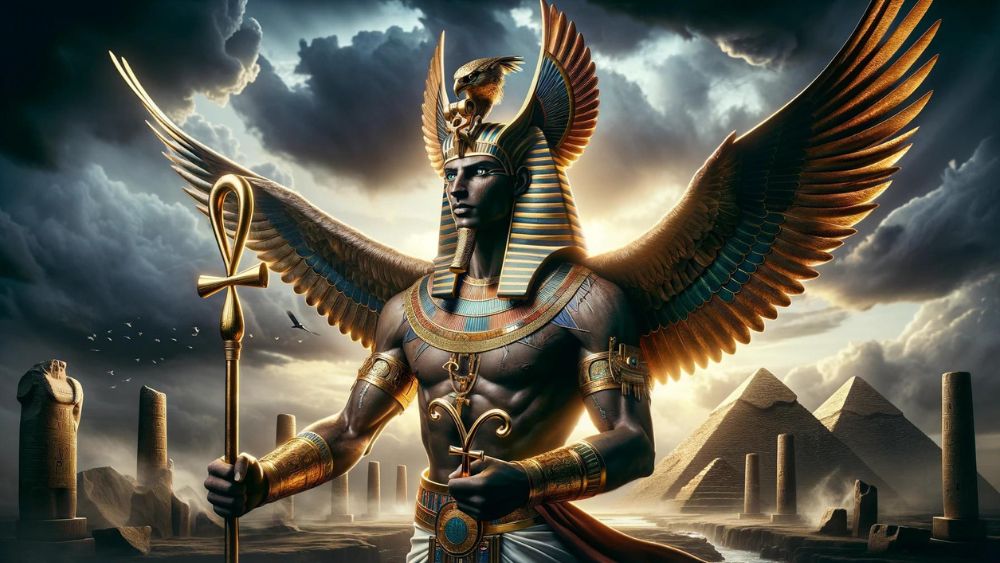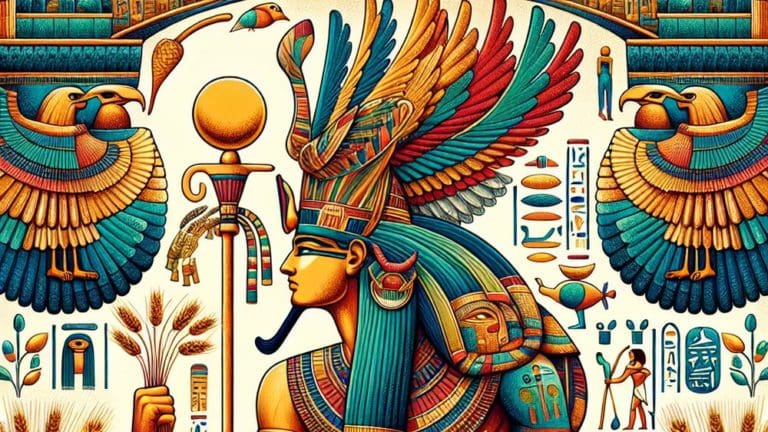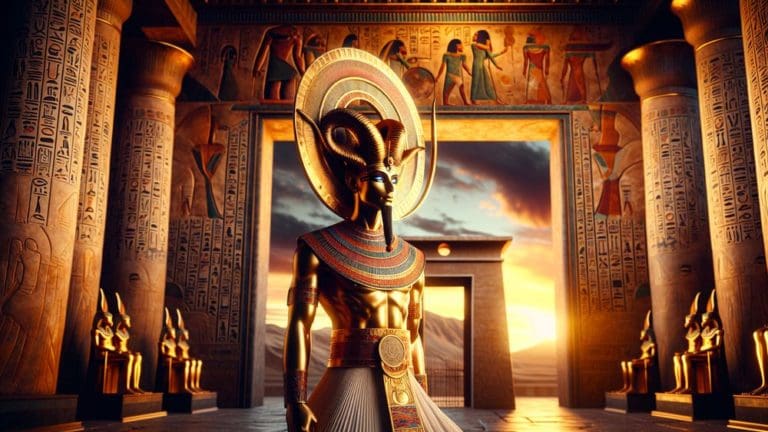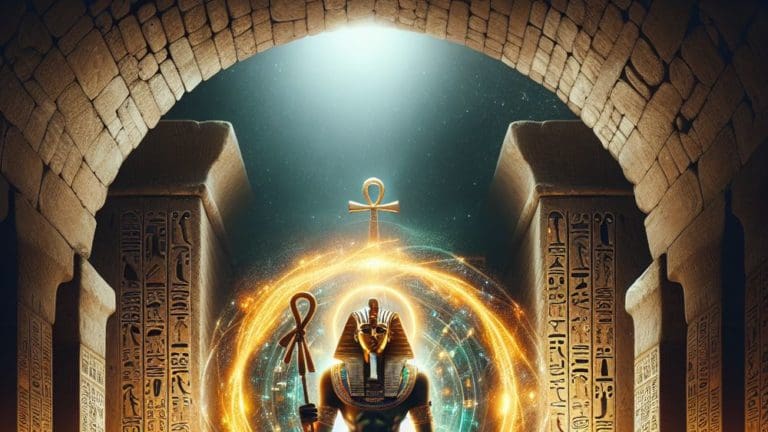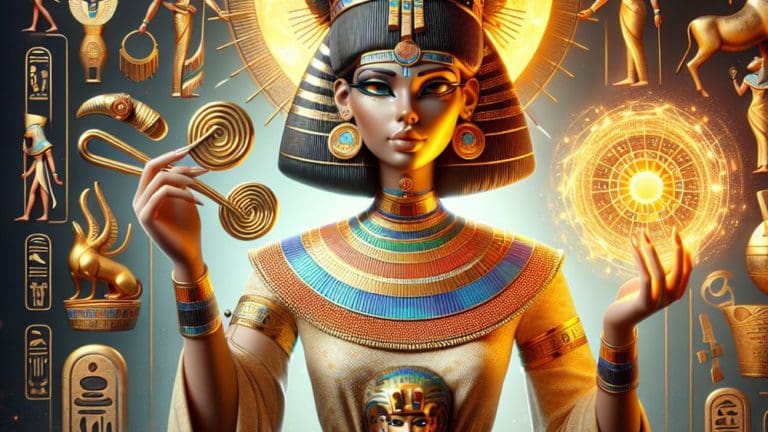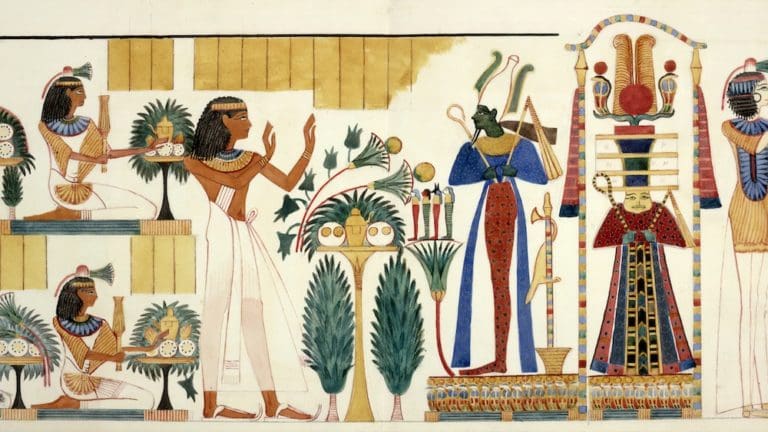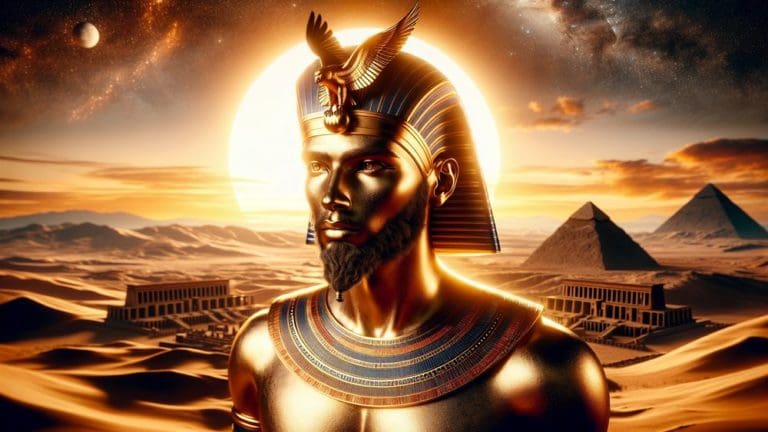Horus: God of the Sky, Protection, and Kingship
The ancient Egyptian world is famous for its deep stories and many gods and goddesses. These stories and characters have caught the attention of people who study history and those who simply love to learn about past cultures for a very long time. In the center of these stories is Horus, a very important god.
Key Points:
- Horus is an ancient Egyptian deity symbolizing kingship and protection.
- Horus is represented as a falcon or a man with a falcon head and is linked to the sky.
- Horus played a crucial role in Egyptian beliefs and was seen as a guide and protector.
- The Eye of Horus symbolizes healing and safety and was widely used in ancient Egypt.
- Horus had different forms and roles, such as Horus the Elder and Horus the Younger.
- Horus was part of key myths involving battles for the throne and afterlife beliefs.
- Temples and centers were built to honor and worship Horus in ancient Egypt.
People in ancient Egypt showed a lot of love and respect for Horus. They often showed him as a falcon or as a man with the head of a falcon. This god stood for being a king, for safety, and for the sky.
Looking into where Horus came from, how people saw him back then, and the different ways they showed their respect and love for him helps us understand more about how people in one of the most interesting parts of history lived and what they believed in.
The Origins and Evolution of Horus
To really get what Horus means, we need to look at where he comes from and how people’s views of him changed over time. This takes us into a story that’s both old and full of changes.
Who is Horus?
Horus plays a very important role in the beliefs and daily life of people in ancient Egypt. They often show him with the head of a falcon which means he is connected to the sky and has power over it.
He is also a symbol of the king’s power and the protector of the people. His job was to keep everything in balance, making sure that good always wins over evil. This made him very special to the people of ancient Egypt. They saw him as a guide for their kings and a guardian for everyone.
Horus was very important for the idea of kingship. The king of Egypt was thought to be Horus in human form. This made the king very special and showed that he had a divine right to lead. Horus also fought against chaos and evil, which was like the king’s duty to protect his land and keep peace.
This connection between Horus and the king helped everyone understand and accept the king’s power and role.
- Key Points: The Eye of Horus means healing and safety.
- Cultural Role: People celebrated Horus with special events and practices.
- Influence Over Time: Kings and builders used Horus’ image to show power and protection.
Horus was a crucial figure in ancient Egyptian beliefs and daily life, symbolizing power, protection, and the balance between good and evil, which ultimately influenced the concept of kingship and societal acceptance of the king’s authority.
The Many Forms of Horus
Horus is quite a special god because he appears in different ways, which show how people in ancient Egypt thought and felt about their gods. There’s a clear difference between Horus the Elder and Horus the Younger. Horus the Elder comes from the very beginning, born from the sky and the earth.
He’s all about light and the sky. Horus the Younger has a different story. He’s the son of Isis and Osiris and is famous for fighting for his father and for being a symbol of coming back to life after death.
These two sides of Horus show us that he was a god with many roles and meanings. When we talk about what Horus represents, it’s interesting to see how each form of him carries different symbols and meanings.
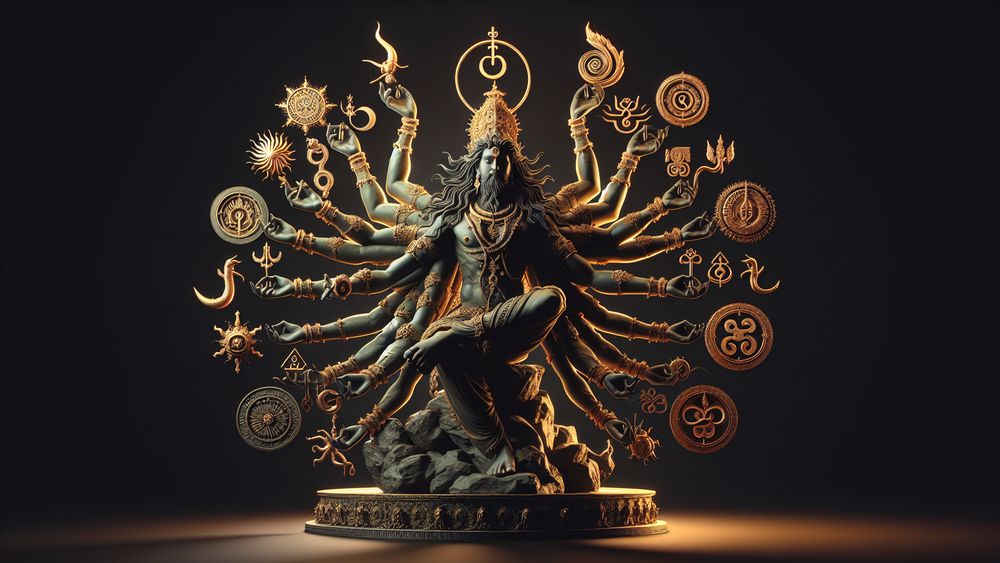
For example, when you see Horus with a falcon’s head, it tells you he’s in charge of the sky and is there to protect and watch over people. The Eye of Horus is another symbol that comes from a story where Horus fights and loses an eye.
This eye is all about healing and keeping people safe. Each way that Horus appears brings its own set of symbols which were very meaningful for people back then. How people showed their love and respect for Horus changed depending on where they were in Egypt.
In some places, he was mainly seen as a sky god and the pharaoh’s protector. In other places, his story as the son of Isis and Osiris was more central, especially when it came to beliefs about death and what comes after.
This variety in how Horus was worshipped tells us that he was a very flexible and beloved god in Egyptian religion, fitting into many different parts of life and belief over time.
- Different Ways Horus Appears:
- As Horus Behdety, he’s linked to the sun and sky.As Harsiesis, which means “Horus, Son of Isis,” his connection to the Osirian myth is clear.
- What These Symbols Mean:
- The falcon head points to his role as king and protector.The Eye of Horus is all about healing and safety.
- How Worship Changed:
- In some cities, Horus was mainly seen as a protector.Over years, which aspect of Horus people focused on could change with the times.
Horus in Myth and Legend
Now, let’s shift our focus to the tales and legends that shine a light on Horus’s role and importance. These stories are like a bridge that connects us to the ancient world of Egypt and its beliefs.
The Birth and Family of Horus
Horus was the son of Isis and Osiris, which made him part of a very special and powerful family in the stories of ancient Egypt. His story starts with something amazing. After Osiris was trickily killed by his brother Seth, Isis, his wife, used her magic to bring Osiris back for a short while. They had Horus during this time.
So, Horus’ story is about overcoming tough situations and keeping his father’s good name alive. Horus and Seth did not get along. Seth was jealous and wanted to take over Osiris’ place. This led to many fights between Horus and Seth. These weren’t small arguments but huge battles that meant a lot more.
They were about who was right and who was wrong, and about keeping everything in order and peaceful. The Egyptians thought these fights were very, very important. They showed the fight between good and bad that goes on forever.
This idea was a big part of what the Egyptians thought and did, especially when it came to their kings and what happens after we die.
Horus’s story revolves around overcoming challenges and preserving his father’s legacy while engaging in intense battles with Seth, which symbolize the eternal struggle between good and evil in Egyptian beliefs.
Key Myths Involving Horus
One very important story is about Horus and his fight with Seth for Egypt’s throne. This wasn’t a simple family fight. It was a huge story that showed the battle between good and bad. Horus was the good guy, wanting everything to be right and fair, like his dad wanted. Seth was the troublemaker, causing chaos.
The fight was very important because it was about keeping everything in balance. When Horus won, it showed that good and fairness would always win. Then, there’s the story of the Eye of Horus. In a fight, Horus lost his eye.
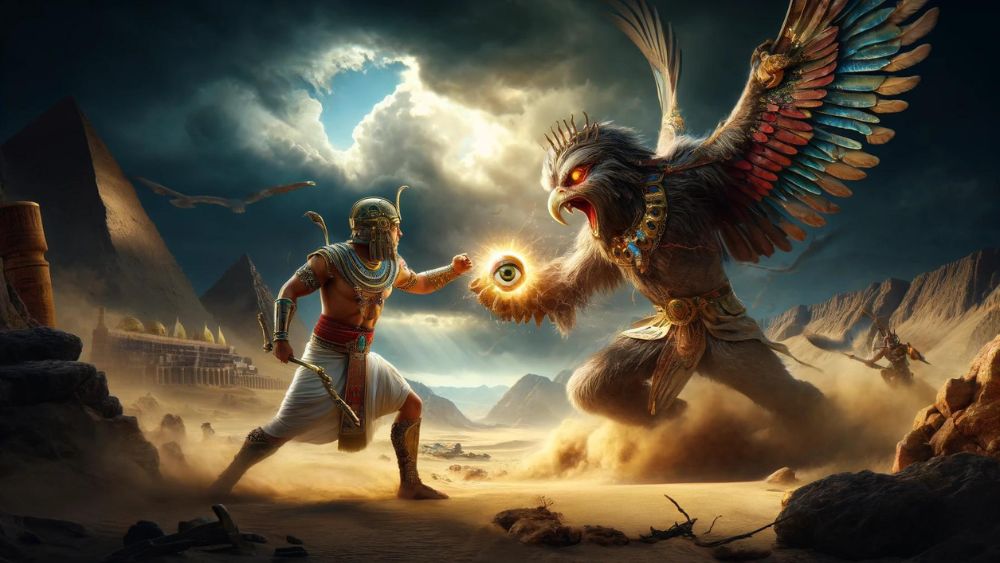
But he got it back, and that eye became a very powerful symbol. It meant healing and keeping people safe. People made amulets that looked like the Eye of Horus because they thought it would protect them and keep them healthy.
This eye was split into six parts, each for a different sense and a fraction which when put together, meant wholeness and health. This story tells us why so many people in ancient Egypt wore this symbol for protection and health.
Horus also had a very special job when it came to what happened after people died. He would take the dead and show them to Osiris, who would decide if they had been good.
In these stories, Horus was like a guide and protector for those who had died. This role made him very important for people when they thought about life after death. It showed that Horus was there for them, both while they were alive and after they passed away.
- Fight for the Throne: Art and writings from that time often show Horus and Seth fighting.The Eye of Horus: People wore this symbol for protection.Afterlife Guide: Pictures in tombs show Horus with the dead, guiding them, which tells us about his role after death.
Symbols and Worship of Horus
We now shift our focus. Let’s look at how people showed their respect for Horus and the symbols that stood for him. This part is quite interesting. Horus was more than a story. People really cared for him and showed it in many ways. They built large and beautiful places where they could honor him.
The Eye of Horus and Its Significance
The Eye of Horus, which people also call “Wadjet,” is very special in ancient Egyptian culture. It means a lot of different but very good and helpful things, especially for keeping people safe and helping them when they are sick. This symbol looks like an eye and has six parts.
Each part is for a different sense, like seeing or hearing, and a fraction that when you add them all up, means being whole and healthy. People wore this symbol as jewelry or put it on their buildings and tombs because they thought it would protect them and keep bad things away.
Aside from keeping people safe, the Eye of Horus was very important for making people feel better when they were sick. They used it in spells and when making medicine because they thought it had the power to make people well again.
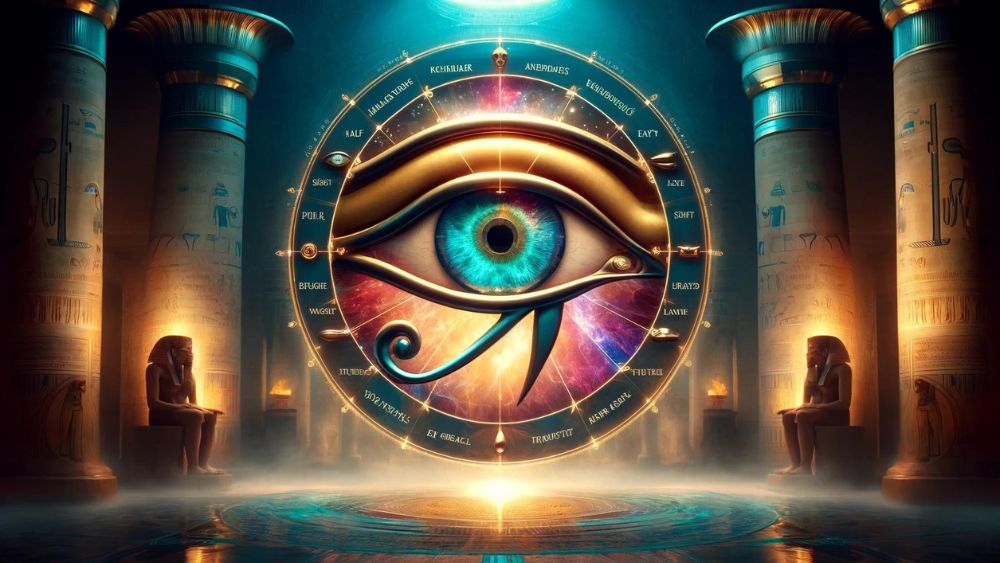
This symbol wasn’t just for protecting the body. People also thought it protected the spirit, especially after someone died. Because it had so many uses and meant so much, the Eye of Horus was one of the symbols that you would see a lot in ancient Egypt.
Here’s a simple way to understand which part of the Eye of Horus was for which sense and what fraction it represented:
- Right side of the eye: This part was for smelling and was half of the whole.
- Pupil: This part meant for seeing and was a quarter.
- Eyebrow: This part stood for thinking and was one-eighth.
- Left side of the eye: This part was for hearing and was one-sixteenth.
- Curved tail: This part was for tasting and was one-thirty-second.
- Teardrop: This part was for touching and was one-sixty-fourth.
When you look at this table, you can see how each part of the Eye of Horus connected to a different way we sense the world and how when you put all these parts together, they mean being complete and healthy.
Temples and Centers of Worship
In the land of ancient Egypt, people built special places for honoring Horus. These places were very large and full of beautiful designs. One famous place is the Temple of Edfu. It’s a huge and very old building that has stood for thousands of years. People went there to perform rituals and celebrate Horus.
This temple, which workers built from 237 to 57 BCE, is very impressive and still attracts many visitors today. Another key location is the Temple of Horus at Behdet, which we now call Edfu.
This place is very special because it connects to the story where Horus wins over Seth, which is a tale about good beating evil. These temples did a lot for the community. They were places where people came together for worship and where leaders made decisions and helped heal the sick.
They also kept and shared knowledge about Horus and how to honor him properly. These centers were very central to the life and culture of those times, making them very crucial for anyone wanting to understand ancient Egypt.
Ancient Egyptian temples dedicated to Horus were central hubs for worship, communal gatherings, and cultural practices, playing a vital role in the society’s life and history.
Horus and His Influence Beyond Egypt
Now, we will look at how the stories and ideas about Horus reached places far from Egypt. Horus was very special, and his stories did indeed travel far and wide.
Connections to Other Deities and Cults
When we look at Horus and what he means, we see that other old religions have gods that are somewhat like him. Take for example, Jupiter from Rome and Zeus from Greece. They are a lot like Horus because they control the sky and keep everything in order.
While Horus is mainly about looking after the king and Egypt, Zeus and Jupiter are the top gods who make sure everything and everyone is in harmony. This tells us that many cultures like the idea of a strong god who watches over justice and keeps peace.
The way Horus became known in places outside of Egypt is quite interesting. History and digging up old sites show that when Egyptians traveled for trade or battles, they shared stories of Horus with people they met.
In some places, these new friends added Horus to their own beliefs but changed his story a bit so it fit better with their own gods and ways of seeing the world.
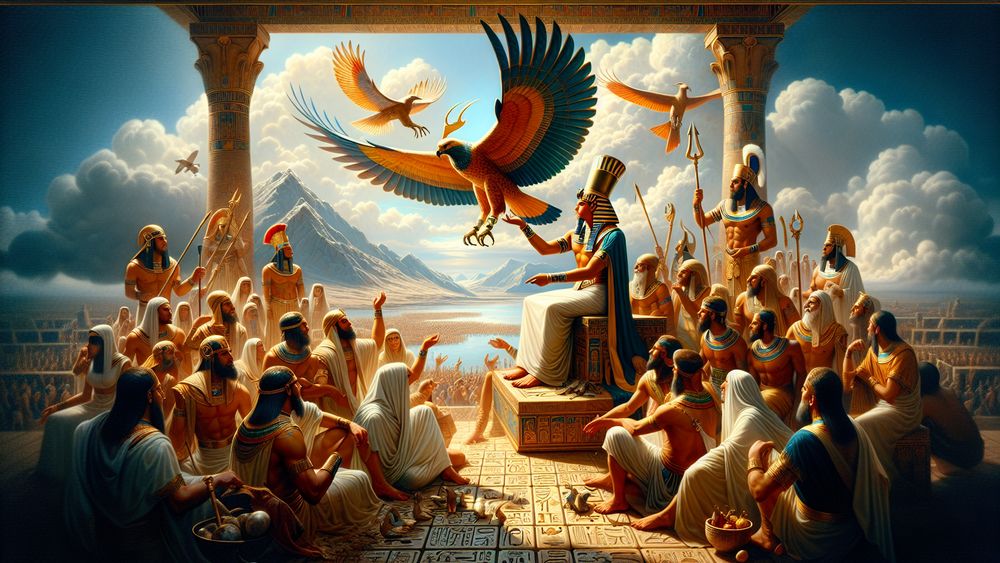
This sharing and changing of Horus’ story show that his message, especially about being a good leader and fighting against chaos, was something many people could relate to and appreciate.
Horus in Modern Times
Today, Horus and stories from Egyptian myths show up a lot in movies and video games. They bring old stories into the now for people to see and enjoy. You might see Horus himself or maybe symbols that remind us of him, like the Eye of Horus.
This eye symbol is everywhere – in designs, on clothes, and even as tattoos because people think it can protect them. Books and comics also tell stories about Horus, making these ancient tales interesting for today’s readers. People today also find meaning in Horus and Egyptian myths for their spiritual life. They use symbols, especially the Eye of Horus, for feeling safe and for healing.
These symbols and stories from Horus’s life give people something to think about and use in their own lives. They look at what Horus did and learn from it, which is pretty amazing because these stories are so old.
This way, Horus and his stories keep living on and touching lives, even now.
- In Entertainment: Video games and movies often have characters or ideas that come from Horus’s story.For Reading: Books and comics bring Horus into stories that are fun and easy to get into.In Personal Beliefs: People use the Eye of Horus for feeling safe and for healing in their daily lives.Around Us: You can see the Eye of Horus in many designs and fashion, which keeps the symbol very much alive and well.
Horus and Egyptian myths are still very much alive and impactful today in entertainment, beliefs, and daily life, with symbols like the Eye of Horus being widely used for protection and healing.
Pantheon of All the Egyptian Mythology Gods
The world of Egyptian mythology is full and complex. It has many gods and goddesses, and each one has their own job and story. These divine beings were very key for the ancient Egyptians.
They touched every part of life, from the everyday to the very grand ideas of what happens after we die and how the world came to be. To really get the whole view and understand this world, it’s good to know about these gods and what they did.
For a full look at all the Egyptian gods, you can check out this complete guide. This place gives you info on both the well-known and the less known gods that were very central to the religious and cultural life in Egypt.
FAQs
1. How did Horus become one of the most worshipped gods in ancient Egypt?
In ancient Egypt, Horus gained great worship because he stood for kingship and protection. These elements were key for Egyptians in their everyday and spiritual lives.
2. What are the differences between Horus the Elder and Horus the Younger?
Horus the Elder comes from the sky and earth gods, while Horus the Younger is the child of Isis and Osiris, mainly known for his connection to rebirth and ruling.
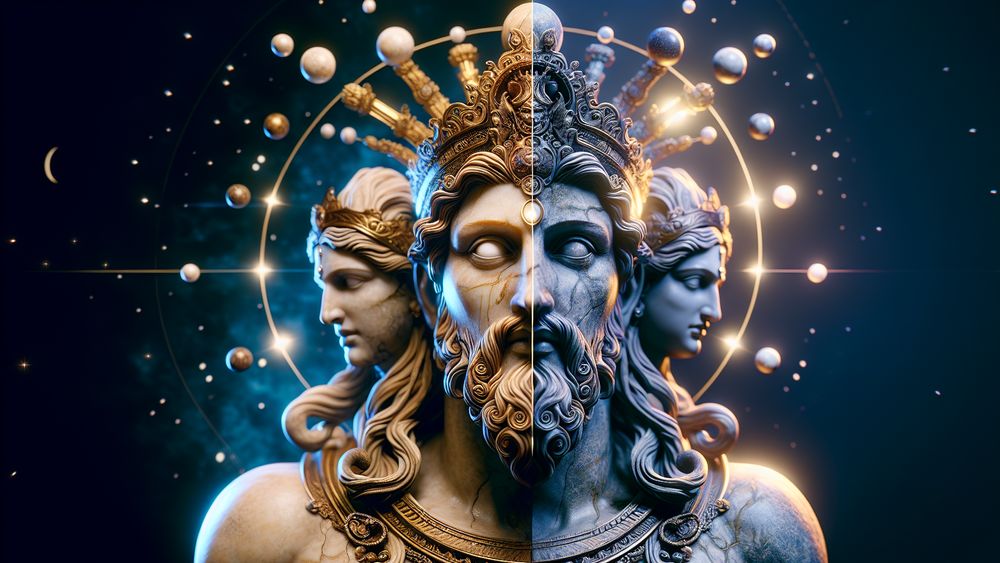
3. How is the Eye of Horus used in modern symbolism and culture?
The Eye of Horus today serves as a symbol for safeguard and healing. People around the world embrace it for its ancient roots and protective power.
4. Can you explain the significance of Horus in the context of Egyptian afterlife beliefs?
In Egyptian afterlife beliefs, Horus is very important because he helps and protects the dead, guiding them safely and standing for life after death and forever living.

